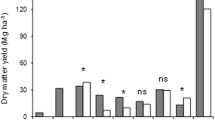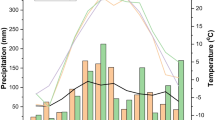Abstract
Harvest management practices affect productivity and persistence of grasses grown for bioenergy, but data are limited that describe their effects on the tall-growing grasses adapted to the USA Gulf Coast region. The objective was to determine harvest frequency and timing effects on biomass yield, nutrient removal, and persistence of three perennial bioenergy grasses in the southeastern USA. The experiment was conducted from 2010 through 2012. Harvest management treatments were two harvests per year (2X; July and November), one harvest per year in early November (fall), and one harvest per year after first freeze (winter). Elephantgrass (Pennisetum purpureum Schum.) cv. Merkeron and breeding line UF1 and energycane (Saccharum spp.) cv. L 79-1002 were compared. Three-year average biomass harvested was greatest for UF1 followed by Merkeron and L 79-1002 (27.8, 24.6, and 21.1 Mg ha−1year−1, respectively). Biomass harvested was not affected by harvest management in 2010 and 2011, but in 2012, the 2X treatment yielded 47 % less than winter. Biomass dry matter (DM) concentration for single harvest treatments was greater than 2X (34 vs. 25 %), but the 2X treatment removed two times more N and P in harvested biomass than fall or winter. For these grasses, fall and winter single harvest treatments were superior to 2X due to greater third year biomass yield, less nutrient removal, and harvested biomass had a greater DM concentration that may be advantageous for postharvest transport and processing.

Similar content being viewed by others
Abbreviations
- DM:
-
Dry matter
References
Cheng J (2010) Biomass to renewable energy processes. CRC Press, Boca Raton, Florida
Perlack RD (2008) Biomass as feedstock for a bioenergy and bioproducts industry: the technical feasability of a billion-ton annual supply. Oak Ridge National Laboratory, Oak Ridge, TN
Knoll JE, Anderson WF, Strickland TC, Hubbard RK, Malik R (2012) Low-input production of biomass from perennial grasses in the coastal plain of Georgia, USA. Bioenerg Res 5:206–214. doi:10.1007/s12155-011-9122-x
Woodard KR, Prine GM (1991) Forage yield and nutritive value of elephantgrass as affected by harvest frequency and genotype. Agron J 83:541–546. doi:10.2134/agronj1991.00021962008300030005x
Woodard KR, Prine GM (1993) Dry matter accumulation of elephantgrass, energycane, and elephantmillet in a subtropical climate. Crop Sci 33:818–824. doi:10.2135/cropsci1993.0011183X003300040038x
Knoll JE, Anderson WF, Richard EP, Doran-Peterson J, Baldwin B, Hale AL, Viator RP (2013) Harvest date effects on biomass quality and ethanol yield of new energycane (Saccharum hyb.) genotypes in the Southeast USA. Biomass Bioenergy 56:147–156. doi:10.1016/j.biombioe.2013.04.018
Bouton JH (2002) Bioenergy crop breeding and production research in the Southeast, Final Report for 1996 to 2001. National Technical Information Service, Springfield, VA
Prine GM, Mislevy P, Shiralipour A, Smith PH (1984) Elephantgrass, energy crop for humid subtropics. In: In 4th Annual Solar and Biomass Energy Workshop. Atlanta, Georgia, pp 124–127
Woodard KR, Sollenberger LE (2008) Production of biofuels crops in Florida: elephantgrass. Florida Cooperative Extension Service, UF/IFAS. http://edis.ifas.ufl.edu/ss418.
Guretzky JA, Biermacher JT, Cook BJ, Kering MK, Mosali J (2011) Switchgrass for forage and bioenergy: harvest and nitrogen rate effects on biomass yields and nutrient composition. Plant Soil 339:69–81. doi:10.1007/s11104-010-0376-4
Kering MK, Butler TJ, Biermacher JT, Mosali J, Guretzky JA (2013) Effect of potassium and nitrogen fertilizer on switchgrass productivity and nutrient removal rates under two harvest systems on a Low Potassium Soil. Bioenerg Res 6:329–335. doi:10.1007/s12155-012-9261-8
Kering MK, Biermacher JT, Butler TJ, Mosali J, Guretzky JA (2012) Biomass yield and nutrient responses of switchgrass to phosphorus application. Bioenerg Res 5:71–78. doi:10.1007/s12155-011-9174-y
Kering MK, Butler TJ, Biermacher JT, Guretzky JA (2012) Biomass yield and nutrient removal rates of perennial grasses under nitrogen fertilization. Bioenerg Res 5:61–70. doi:10.1007/s12155-011-9167-x
USDA/NRCS (2013) Web soil survey. USDA Natural Resource Conservation Service. http://websoilsurvey.nrcs.usda.gov/. Accessed 24 April 2014
Mylavarapu R, Wright D, Kidder G, Chambliss C (2009) UF/IFAS standard fertilization recommendations for agronomic crops. Florida Cooperative Extension Service, UF/IFAS. http://edis.ifas.ufl.edu/ss163.
Burton GW (1989) Registration of ‘Merkeron’ napiergrass. Crop Sci 29:1327–1327. doi:10.2135/cropsci1989.0011183X002900050050x
Bischoff KP, Gravois KA, Reagan TE, Hoy JW, Kimbeng CA, LaBorde CM, Hawkins GL (2008) Registration of ‘L 79-1002’ sugarcane. J Plant Reg 2:211–217. doi:10.3198/jpr2007.12.0673crc
Woodard KR, Prine GM, Bates DB (1991) Silage characteristics of elephantgrass as affected by harvest frequency and genotype. Agron J 83:547–551. doi:10.2134/agronj1991.00021962008300030006x
Sollenberger LE, Woodard KR, Vendramini JMB, Chase CD, Lopez Y, Gallo M, Seib J, Langeland KA, Gerardo-Cuervo H (2011) Are all elephantgrasses invasive? Characterization of natural populations and cultivated types of a bioenergy grass in Florida. ASA-CSSA-SSSA Annual Meeting, San Antonio, TX, In
Vicente-Chandler J, Silva S, Figarella J (1959) The effect of nitrogen fertilization and frequency of cutting on the yield and composition of three tropical grasses. Agron J 51:202–206. doi:10.2134/agronj1959.00021962005100040006x
Gallaher RN, Weldon CO, Futral JG (1975) An aluminum block digester for plant and soil analysis. Soil Sci Soc Am J 39:803–806. doi:10.2136/sssaj1975.03615995003900040052x
Hambleton LG (1977) Semiautomated method for simultaneous determination of phosphorus, calcium and crude protein in animal feeds. J Assoc Off Anal Chem 60:845–852
SAS Institute (2008) SAS Online DOC 9.2
Woodard KR, Prine GM, Bachrein S (1993) Solar energy recovery by elephantgrass, energycane, and elephantmillet canopies. Crop Sci 33:824–830. doi:10.2135/cropsci1993.0011183X003300040039x
NOAA (2014) Fall freeze occurrence 10 % probability 28 F (−2 C) or less on an earlier date. National Climatic Data Center. http://www1.ncdc.noaa.gov/pub/data/images/Fall28F_hires.jpg. Accessed 23 April 2014
León RG, Gilbert RA, Korndorfer PH, Comstock JC (2012) Selection criteria and performance of energycane clones (Saccharum spp. ×S. spontaneum) for biomass production under tropical and sub-tropical conditions. CEIBA 51:11
Mislevy P, Martin FG, Adjei B (1989) Changes in elephant grass plant components with maturity: I Percentage dry yield. In: Proc. Int. Grassl. Congr.16th, Nice, France, The French Grassl. Soc., pp 951–952
Chaparro CJ, Sollenberger LE, Jones CS (1995) Defoliation effects on ‘Mott’ elephantgrass productivity and leaf percentage. Agron J 87:981–985. doi:10.2134/agronj1995.00021962008700050034x
Hanna WW, Chaparro CJ, Mathews BW, Burns JC, Sollenberger LE, Carpenter JR (2004) Perennial Pennisetums. In: Moser LE, Burson BL, Sollenberger LE (eds) Warm-season (C4) grasses. ASA-CSSA-SSSA, Madison, WI, pp 503–535. doi:10.2134/agronmonogr45.c14
Williams MJ, Hanna WW (1995) Performance and nutritive quality of dwarf and semi-dwarf elephantgrass genotypes in the south-eastern USA. Trop Grasslands 29:122–127
Sokhansanj S, Mani S, Turhollow A, Kumar A, Bransby D, Lynd L, Laser M (2009) Large-scale production, harvest and logistics of switchgrass (Panicum virgatum L.)—current technology and envisioning a mature technology. Biofuels Bioprod Bioref 3:124–141. doi:10.1002/bbb.129
Brechbill S, Tyner W, Ileleji K (2011) The economics of biomass collection and transportation and its supply to indiana cellulosic and electric utility facilities. Bioenerg Res 4:141–152. doi:10.1007/s12155-010-9108-0
Lewandowski I, Heinz A (2003) Delayed harvest of miscanthus—influences on biomass quantity and quality and environmental impacts of energy production. Eur J Agron 19:45–63. doi:10.1016/s1161-0301(02)00018-7
Erickson JE, Woodard KR, Sollenberger LE (2012) Optimizing sweet sorghum production for biofuel in the southeastern USA through nitrogen fertilization and top removal. Bioenerg Res 5:86–94. doi:10.1007/s12155-011-9129-3
Costa JL, Gomide JA (1991) Drying rates of tropical grasses. Trop Grasslands 25:325–332
Spitaleri RF, Sollenberger LE, Staples CR, Schank SC (1995) Harvest management effects on ensiling characteristics and silage nutritive value of seeded Pennisetum hexaploid hybrids. Postharvest Biol Technol 5:353–362. doi:10.1016/0925-5214(94)00033-O
Na C, Sollenberger LE, Erickson JE, Woodard KR, Castillo MS, Mullenix MK, Vendramini JMB, Silveira ML Management of warm-season bioenergy grasses. II. Seasonal differences in elephantgrass and energycane morphology affect responses to harvest frequency and timing. Bioenergy Res (in review).
Wilson DM, Dalluge DL, Rover M, Heaton EA, Brown RC (2013) Crop management impacts biofuel quality: influence of switchgrass harvest time on yield, nitrogen and ash of fast pyrolysis products. Bioenerg Res 6:103–113. doi:10.1605/01.301-0021911650.2013
Waramit N, Moore KJ, Heggenstaller AH (2011) Composition of native warm-season grasses for bioenergy production in response to nitrogen fertilization rate and harvest date. Agron J 103:655–662. doi:10.2134/agronj2010.0374
Manyawu GJ, Chakoma C, Sibanda S, Mutisi C, Chakoma IC (2003) The effect of harvesting interval on herbage yield and nutritive value of napier grass and hybrid Pennisetums. Asian Austral J Anim Sci 16:996–1002
Sollenberger LE, Woodard KR, Vendramini JMB, Erickson JE, Langeland K, Mullenix MK, Na C, Castillo M, Gallo M, Chase C, López Y (2014) Invasive populations of elephantgrass differ in morphological and growth characteristics from clones selected for biomass production. Bioenerg Res. doi:10.1007/s12155-014-9478-9 (currently available online)
Acknowledgments
We gratefully acknowledge the assistance of Dwight Thomas, Jim Boyer, Miguel Castillo, Kim Mullenix, Nick Krueger, and Marcelo Wallau in the data collection and field management.
Author information
Authors and Affiliations
Corresponding author
Rights and permissions
About this article
Cite this article
Na, CI., Sollenberger, L.E., Erickson, J.E. et al. Management of Perennial Warm-Season Bioenergy Grasses. I. Biomass Harvested, Nutrient Removal, and Persistence Responses of Elephantgrass and Energycane to Harvest Frequency and Timing. Bioenerg. Res. 8, 581–589 (2015). https://doi.org/10.1007/s12155-014-9541-6
Published:
Issue Date:
DOI: https://doi.org/10.1007/s12155-014-9541-6




